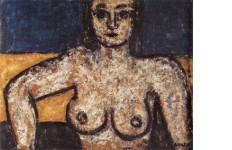TITΛΟΣ ΕΡΓΟΥNU DE CARINA
ΔΙΑΣΤΑΣΕΙΣ ΕΡΓΟΥΎψος : 72
Πλάτος : 93
ΥΛΙΚΟ ΚΑΤΑΣΚΕΥΗΣΜικτή Τεχνική (Λάδι και Παστέλ σε Καμβά)
ΥΠΟΓΡΑΦΗ ΚΑΛΛΙΤΕΧΝΗΚάτω Δεξιά
ΧΡΟΝΟΛΟΓΗΣΗ
ΕΛΕΓΧΟΣ ΓΝΗΣΙΟΤΗΤΑΣΔεν έχει ελεγχθεί

Exhibited:
Paris, Pont Neuf, NONDA, Jour et Nuit, Sous le Pont Neuf May, 1963 (sponsored by the City of Paris).
Paris, Galerie Charpentier.
Ever since NONDAs first one-man show in Athens (1952) sparked a national scandal with his daring nudes he has been considered one of the most revolutionary and expressive Greek artists who lived and worked in Paris. NONDA, a student of Vikatos and Demetrios Galanis, began his career with a scholarship granted in 1947 from the French Academy in Athens to study at the Ecole des Beaux-Arts in Paris. In 1956, encouraged by Galanis and the poet/novelist, Francis Carco, NONDA earned his place in the Ecole de Paris among the masters of the 20th century.
In 1960, with the personal interest of the French Minster of Culture, André Malraux, NONDA became the first painter to transform the arches of the Pont Neuf bridge in Paris into a one-man show of enormous canvases and sculptures, thereby reviving a tradition of public outdoor exhibitions in Europe which had lain dormant since Boucher and Chardin in the 18th century. Art Critic and historian Athena Schina has credited NONDA for pioneering the idea of public installations in France and Europe.
NONDA exhibited in all the historic shows at the Grand Palais which included the Salon dHiver, Salon dAutomne, Salon des Indépendants and Salon des Surindépendants, with Picasso, Braque, Miro, Léger, Chagall and many others. In 1956 a contract with the Galerie Charpentier was secured.
Nu de Carina is one of the few works by NONDA which reveals the name of one of his many models in Paris from the period of 1950-60. Nu de Carina is a unique work in oils and pastels from a series of women he painted in the early 1960s in Paris using the technique which would later be called his fresco period because of its resemblance to stone relief and ancient murals of Etruria, Egypt and Crete. NONDA has been hailed as pioneer in the mysterious treatment of the female figure, the explosive but controlled force of eroticism and the metaphysical gaze that tends to reoccur and create startling connections between his many different styles. This painting is one of only two known remaining portraits of Carina and truly represents the fascinating age of mid 20th century Paris.